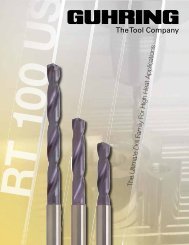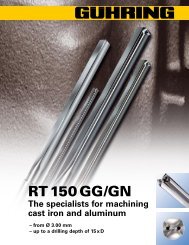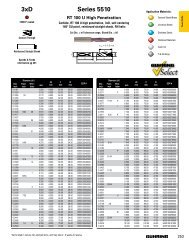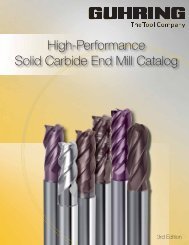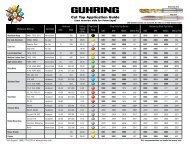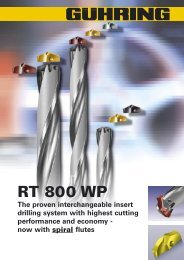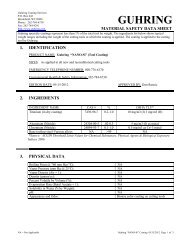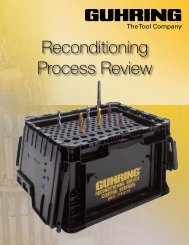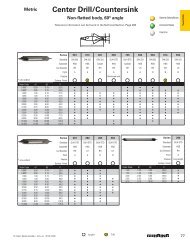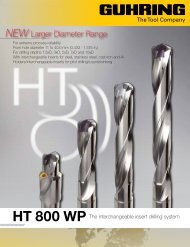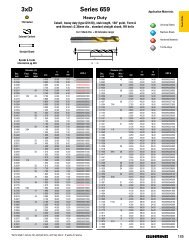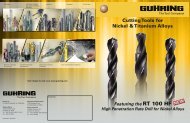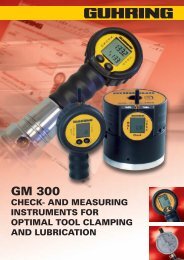You also want an ePaper? Increase the reach of your titles
YUMPU automatically turns print PDFs into web optimized ePapers that Google loves.
Top performer in key benchmark tests:<br />
Best in tool wear and life<br />
In technical third-party tests performed<br />
by the Technical University of Darmstadt<br />
(PTW Darmstadt – Darmstadt, Germany),<br />
the <strong>RT</strong> <strong>100</strong> R significantly outperformed<br />
all competitors in machining CGI,<br />
registering the lowest tool wear while<br />
scoring the highest tool life.<br />
In the first test, tool wear was<br />
compared by measuring the cutting<br />
edge wear width of 5.00 mm diameter<br />
drills after they had machined 5,000<br />
20 mm-deep holes for a total depth of<br />
<strong>100</strong> m. As shown in Diagram 1 below,<br />
the tool wear of the <strong>RT</strong> <strong>100</strong> R was only<br />
0.196 mm, the lowest figure among the<br />
7 tools tested.<br />
As a key indicator of potential total tool<br />
life, outer corner wear was also measured<br />
(See Diagram 2). Even after 5,000 holes,<br />
the <strong>RT</strong> <strong>100</strong> R registered little corner wear,<br />
suggesting that the tool could be used to<br />
machine considerably more holes.<br />
A second test was conducted to measure<br />
face wear and to confirm total tool life.<br />
For this test, the technicians selected<br />
step drills with an inside cutting diameter<br />
of 14.50 mm and an outside diameter of<br />
20.00 mm with a 45° chamfer at the step.<br />
Based on the results of the first test, a<br />
total tool life of 120 m (approx. 1,715<br />
holes at a depth of 70 mm per hole) was<br />
expected. Not only did the <strong>RT</strong> <strong>100</strong> R<br />
dominate the test, it was well on its<br />
way to doubling the pre-test predictions<br />
when the test was called. At that point,<br />
the <strong>RT</strong> <strong>100</strong> R step drill had cut a total of<br />
3,057 holes, or a total depth of 214 m<br />
(See Figure 3). It displayed a very even<br />
wear pattern, was the only tool whose<br />
coating was still intact at the leading<br />
land, and could have kept on producing<br />
more holes!<br />
Diagram 1: Cutting edge wear width after drilling total depth of <strong>100</strong> m<br />
workpiece material = GGV40<br />
coolant pressure = 65 bar speed = 80 m/min feed = 0.20 mm/rev.<br />
hole diameter = 5.00 mm hole depth = 20 mm no. of holes = 5,000<br />
Width of wear Vb (mm)<br />
0.55<br />
0.50<br />
0.45<br />
0.40<br />
0.35<br />
0.30<br />
0.25<br />
0.20<br />
0.15<br />
0.10<br />
0.05<br />
0<br />
1<br />
2 3 4 5 6 <strong>RT</strong> <strong>100</strong> R<br />
Competitor<br />
Diagram 3: Face wear and life<br />
workpiece material = GGV40<br />
coolant pressure = 50 bar speed = 70 m/min feed = 0.30 mm/rev.<br />
hole diameters = 14.50 mm x 20.00 mm<br />
hole depth = 70 mm<br />
Development of outer corner wear VB in µm<br />
Diagram 2: Outer corner wear after drilling total depth of <strong>100</strong> m<br />
1.0<br />
Width of wear Vb (mm)<br />
0.9<br />
0.8<br />
0.7<br />
0.6<br />
0.5<br />
0.4<br />
0.3<br />
0.2<br />
0.1<br />
0<br />
Competitor 1<br />
Competitor 2<br />
<strong>RT</strong> <strong>100</strong> R<br />
holes<br />
5000<br />
4500<br />
3900<br />
3300<br />
2700<br />
2<strong>100</strong><br />
1500<br />
900<br />
300<br />
12.7 25.4 38.1 50.8 88.9 114.3 190.5 215.9<br />
Tool life in m<br />
0 <strong>100</strong> 200 300<br />
Wear Vb in mm<br />
<strong>RT</strong> <strong>100</strong> R



